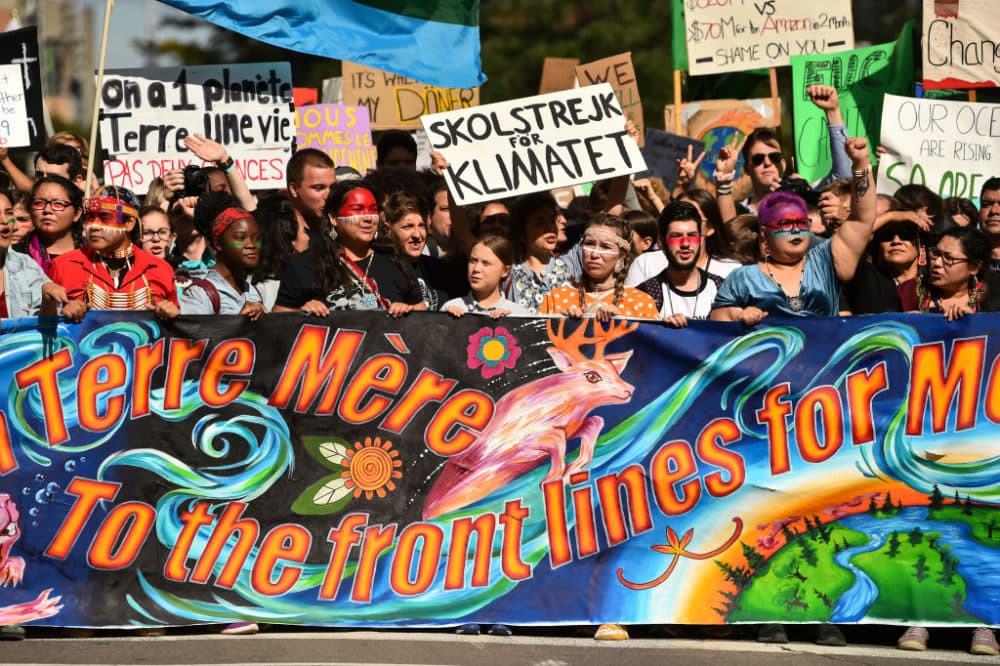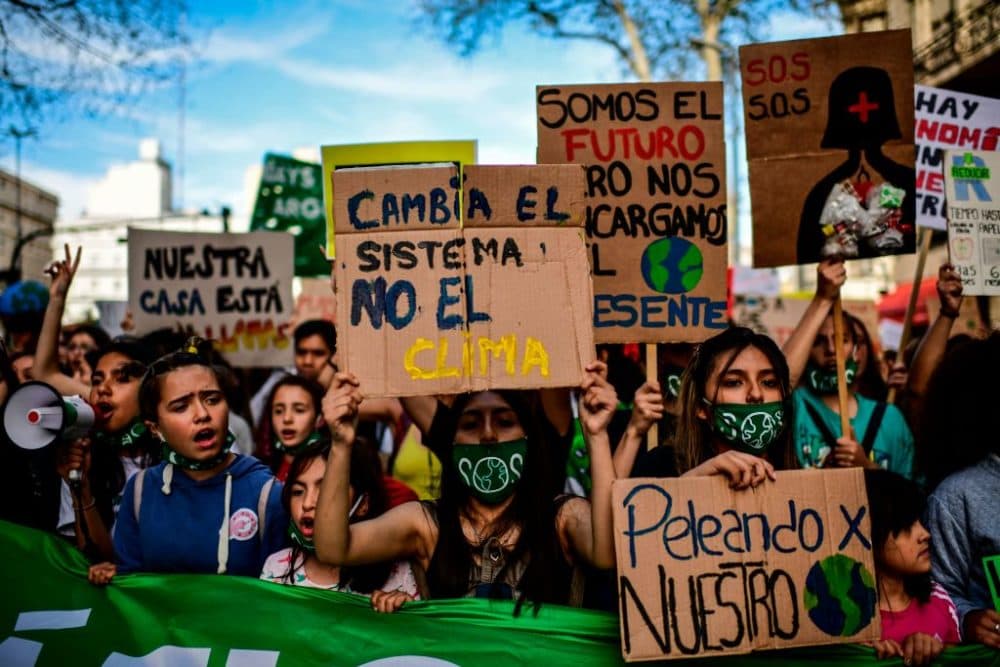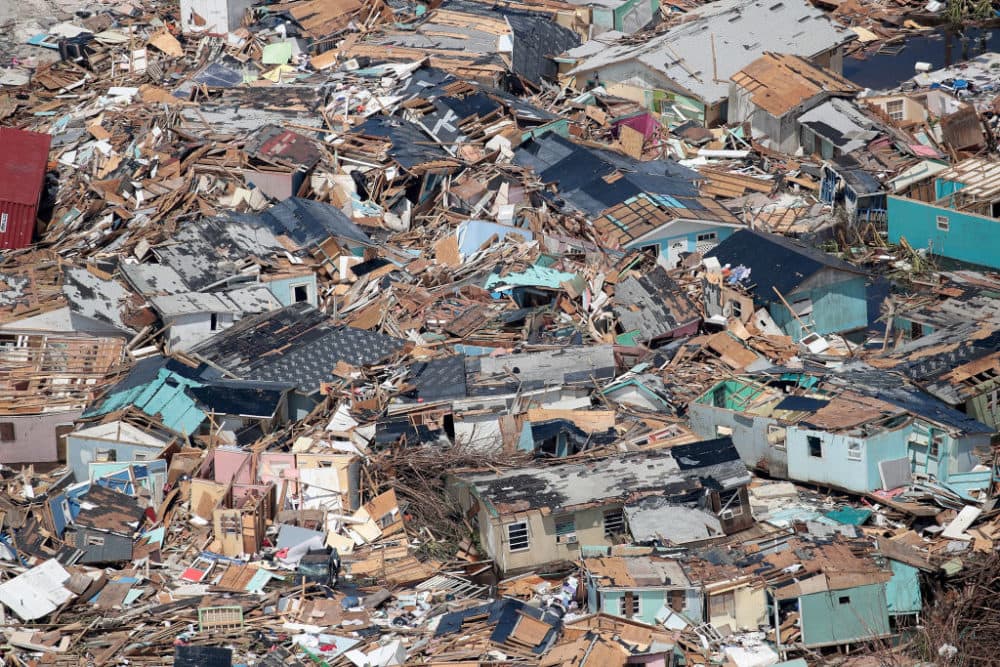Advertisement
Covering Climate
Floods, Wildfires And Students On The Street: Climate Change In 2019

Climate change is hard to talk about. Disastrous but slow-moving, it often takes a backseat to gripping headlines like this year’s historic impeachment.
Still, there are flash points — a storm, a speech by a teenager — that bring the issue into focus.
2019 began with massive flooding in the U.S. and ended with a toothless climate summit. But this past year also saw unprecedented global activism led by young people that has “shaken us all to our cores,” says environmental journalist Zoë Schlanger.
What did 2019 mean for climate change? We look at the five biggest threads of the year: worldwide activism; a wave of extreme weather events from the Mississippi River to Mozambique; a series of major United Nations reports on everything from biodiversity to the oceans; inaction among global leaders; and a shift in the conversation among scientists and the media to explicitly link individual weather phenomena to climate change.
A Groundswell Of Activism
Millions of people took to the streets in September to call for climate change action, led by a surge of student activism. They rallied from India to Brazil, while climate activist Greta Thunberg chastised world leaders at the U.N. Climate Summit.

The Swedish activist, whose Friday school strikes sparked the global movement, came close to tears as she spoke.
“You have stolen my dreams and my childhood with your empty words,” Thunberg said. “People are suffering. People are dying. Entire ecosystems are collapsing. We are in the beginning of a mass extinction. And all you can talk about is money and fairy tales of eternal economic growth.”
While the teen has captured international attention — and the attention of President Trump — she has directed the focus towards scientists and fellow activists. Two youth-led movements, Zero Hour and Sunrise Movement, have gained traction and pushed the Green New Deal into mainstream political discourse. And teenagers have blossomed into major activists, including Zero Hour founder Jamie Margolin, and Isra Hirsi, cofounder of the U.S. Youth Climate Strike.
Major U.N. Studies
In a hearing before the U.S. Congress in September, Thunberg submitted the 2018 IPCC Special Report on Global Warming, which outlined the consequences of 1.5 degrees of warming.
"I am submitting this report as my testimony because I don’t want you to listen to me," she said. "I want you to listen to the scientists.”
In 2019, the U.N. continued to publish report after report, with drastic warnings about the planet’s future. The reports raised alarms about threats to the world’s food supply, a “climate apartheid” where the rich pay to escape the effects of climate change, and a massive loss of biodiversity as more than a million plant and animal species face extinction. A report on the oceans looked at monumental change to the environments that cover more than 80% of the world’s surface — and what sea level rise means for humans.
“Each 100-year flood, for example, is due to come every single year by 2050, in more than a dozen major cities in the world, including places like L.A. and Savannah and Sydney,” Schlanger says.
Advertisement
Intense, Costly And Rare Climate Phenomena Across The World
For many people around the globe, the near-apocalyptic scenarios depicted in those U.N. reports are already here.
Flooding clogged up the Midwest for the first half of this year, as water spilled over the banks of the Missouri, Mississippi and Arkansas Rivers and collected in farmers’ fields. Flooding caused at least $2 billion dollars in damages by some estimates, and many affected states sought relief from the federal government.
Bryan Tuma, assistant director of Nebraska’s Emergency Management Agency, told The New York Times the floods were “biblical.”
Across the world, two storms slammed into Mozambique and its East African neighbors in one season for the first time in recorded history. The spring cyclones killed some 1,000 people in Mozambique, Zimbabwe and Malawi, displaced hundreds of thousands and destroyed infrastructure across the region.
In the fall, slow-moving Hurricane Dorian killed dozens of people and caused more than $3 billion in damage in the Bahamas.
On the other end of the weather spectrum, the planet’s hottest decade on record ended with unprecedented heat waves across Europe and Australia. High temperatures hit some European cities that haven’t relied on air conditioning especially hard.
“And air conditioning is actually a hidden and rising storyline throughout climate change,” Schlanger says. “As the weather warms, more and more people will begin adopting air conditioning that didn't have it before, and air conditioning itself produces quite a bit of emissions.”
Amid high temperatures, wildfires blazed everywhere from the Amazon, “the world’s lungs,” to Greenland, which had to rely on firefighting support from other nations because it couldn’t battle the blazes alone.

Global Inaction
World leaders pledged $20 billion to help fight the fires in the Amazon. But they were unable to find consensus when it comes to fighting climate change. At the 2019 U.N. Climate Change Conference in Madrid, near the end of the year, countries punted major issues down the line, unable to make progress within the framework of the Paris climate agreement.
“We saw the U.S., along with several other of the wealthiest nations, completely block any real progress towards making more ambitious climate goals a reality,” Schlanger says.
António Guterres, the U.N. secretary general, called the summit a missed opportunity.
Meanwhile, Trump started the yearlong process to pull the U.S. out of the Paris agreement by November 2020, calling it “horrible,” “costly” and “one-sided.”
And as international cooperation falters, the paths to limiting climate change narrow. According to a November U.N. report, the current pace of emissions could lead to as much as 3.2 degrees Celsius of warming by 2100. To meet the 1.5 degree warming threshold, the world would have to cut emissions by more than 7% a year for the next decade. Meanwhile, global emissions of carbon dioxide, methane and other greenhouse gases continue to rise steadily.
A Shift In Conversation Thanks To Attribution Science
With widespread environmental changes all but inevitable, scientists have sharpened their tools to describe the impact of climate change — and Schlanger says the media is catching up.
“I think 2019 was really the year that you could not have an extreme event go by without the news media, but also scientists outwardly connecting it to climate change,” Schlanger says. “And that's a major shift.”
That’s due in large part to advances in attribution science, she says, the study that allows scientists to determine exactly how much worse human-caused climate change made a climate event, like a flood or a fire. Over the past few years, that study has progressed rapidly, thanks in part to increased computing power that allows scientists to quickly run sophisticated models of a ‘Planet B,’ a parallel Earth untouched by climate change.

One of the most obvious examples is the heatwave that struck parts of Europe this summer. Scientists found climate change made the record-breaking temperatures five times more likely than they would have been on Planet B.
Friederike Otto, a climate researcher at the University of Oxford, U.K., who worked on that analysis, warns that attribution science findings are probabilistic, not certain.
“There are indeed caveats, mostly to do with imperfect climate models,” Otto told Nature. “But even with large uncertainty bars, we think it is useful to provide quantitative evidence for how climate change is affecting extreme weather.”
That quantitative evidence has already shifted the conversation around climate change. How far it can take us is a question for next year — and future generations.
This segment aired on December 27, 2019.

